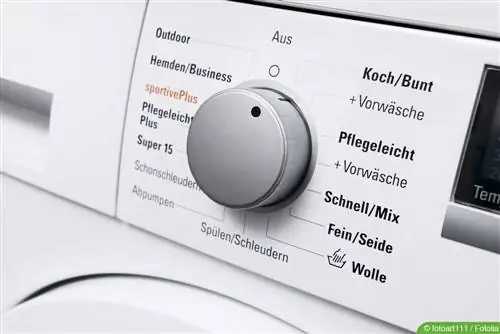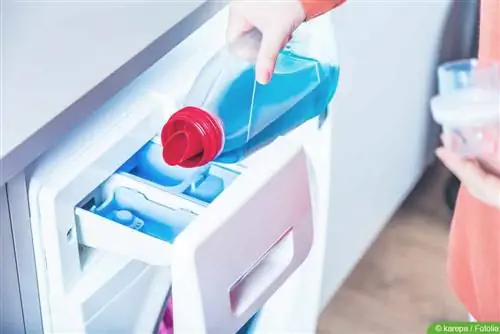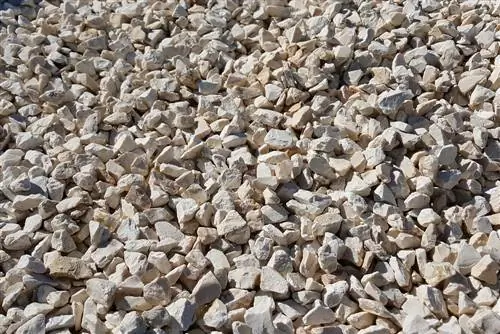- Author admin [email protected].
- Public 2023-12-17 03:39.
- Last modified 2025-01-24 12:45.
Standing water in the fabric softener compartment can affect any washing machine. If the compartment is more than half full or contains watered-down fabric softener, you should clean the machine immediately.
Cause
Water in the fabric softener compartment can affect all types of machines. The reason is that detergent and fabric softener are always fed into the machine via the same channel. After a while, residues, especially detergent, settle there and clog the inlet openings.
This is often not noticeable with detergent because water is pumped in several times, which means that most of it is dissolved and ends up in the washing water. Only with fabric softener, where only one pumping process takes place, is it noticeable if water remains standing or the fabric softener remains watered down in the compartment and the water no longer drains completely before the wash cycle is finished.
Note:
The problem occurs much more often if you use powder detergent and fabric softener concentrate. There is a risk that it will not dissolve well and therefore clog the openings to the washing area.
First remedy
If water remains in the machine, this can cause unpleasant smells. This can even go so far that you have to replace rubber or plastic parts because the smell does not go away despite cleaning products. Therefore, if you notice that there is an above-average amount of water in the fabric softener compartment, you should empty the water.
Then you should completely open the openings on the machine, regardless of whether it is a front loader or top loader. This allows any remaining water in the machine to evaporate. If the water remains in the fabric softener compartment, this is usually a sign that the water inflow and outflow is not working properly in other areas of the machine and that residual water has also collected there, which can start to stink in a closed machine.
Basic cleaning of the washing machine
The outflow and inflow of the fabric softener compartment is not standardized and can look different. Often it is a smaller hole and the fabric softener is pumped into the drum via a pressure valve that opens when the water runs in, taking the fabric softener with it. It's not uncommon for fabric softener residue to get stuck there and clog the opening.

Therefore, all areas for inflow and outflow must be cleaned, because poor drainage can also leave water behind in the compartment. To clean, follow these steps:
- Remove fabric softener/detergent compartment
- Rinse compartment thoroughly with water
- check whether there is a greasy film of detergent residue and rinse again if necessary
- Clean the water inlet to the washing drum
- If necessary, remove further components according to the operating instructions for easier cleaning
- Cleaning the lint filter
- maybe. Check the drain cuff to see whether items of laundry are blocking the drain (only necessary for front loaders)
- Clean the inlet hose including Aquastop (if available)
Tip:
Use a bottle brush when cleaning, as this allows you to easily reach hard-to-reach areas.
Prevent water accumulation
If the problem occurs frequently or if an above-average amount of water quickly returns to the fabric softener compartment after cleaning, you should clean more frequently. To do this, you don't always have to clean the machine, but rather carry out washing cycles with vinegar.
Vinegar is a popular home remedy that effectively removes leftover fabric softener and detergent. Vinegar also has other advantages:
- decalcifying effect
- antibacterial
- neutralizes odors
Around 30-60 ml of standard household vinegar is used per wash cycle. Under no circumstances should you use vinegar essence as it is too concentrated.
Replace fabric softener
One reason why the inlets to the drum quickly become clogged is that many households use too much fabric softener and detergent. With the machines, the amount of water that runs into the machine is precisely calculated. If there is too much detergent or fabric softener in the compartments and cannot be properly dissolved with the amount of water pumped in, the inlets can quickly become blocked. Therefore, the amount of detergent for washing should be chosen according to the program and the amount of laundry in the machine.
Use alternatives
However, many are switching entirely to alternative means. Vinegar, for example, is not only a good way to clean the machine, it can also be used as an alternative to conventional fabric softeners.
Instructions
The same amount of vinegar that you use to clean the machine can also be used to soften the fabric. If you have very hard water, use 60 ml of vinegar. The smell of the vinegar disappears within a short time after drying. By replacing vinegar as fabric softener, you will no longer have problems with water in the fabric softener compartment that remains due to a blocked inlet.






